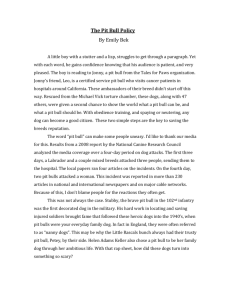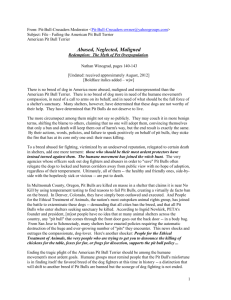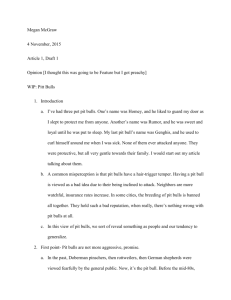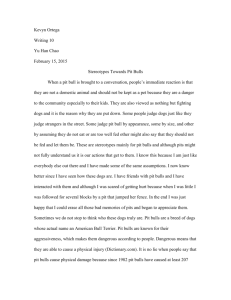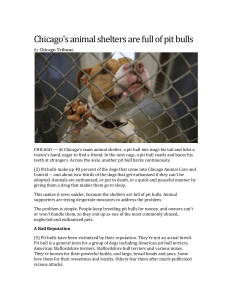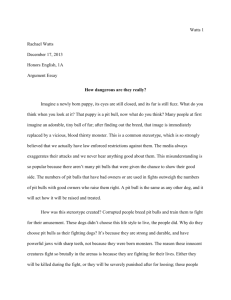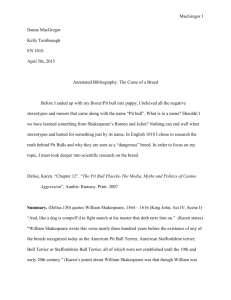Virtual Pet Behaviorist: The Truth about Pit Bulls
advertisement
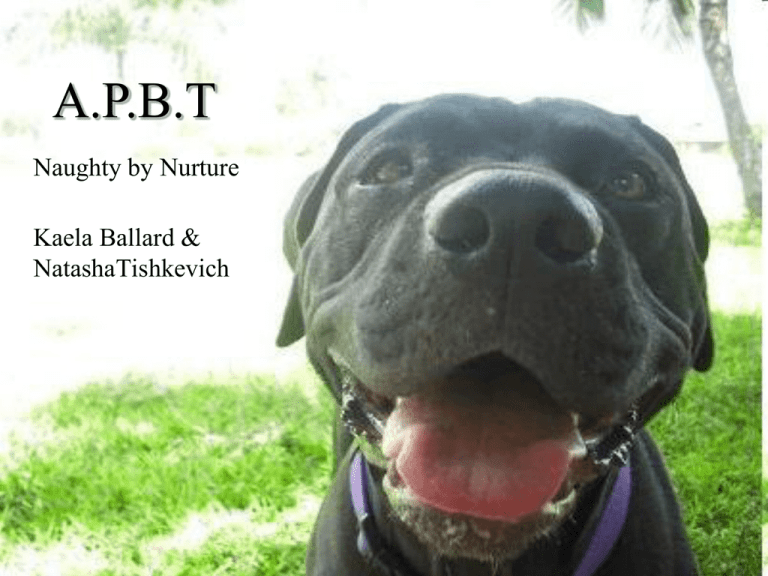
A.P.B.T Naughty by Nurture Kaela Ballard & NatashaTishkevich Introduction • The American Pit Bull Terrier was once one of the highest regarded breeds; now commonly believed to be one of the most dangerous • Those who are familiar with the breed praise them for their temperament and distinctive traits, while those who oppose them, vocalize their fears of the dog’s strength, power and aggression. History of the Breed • The Romans discovered the breed during their invasion of Britain, where the dogs fought alongside their owners. • When Bull-baiting was banned, dog fighting grew into a popular bloodsport. • During WWI Pit Bulls were admired for their courage, strength and loyalty. • Soon after WWI, government took notice to the increase in Pit Bull related deaths. Nurture •Breed experts and trainers claim that Pit Bulls, when well trained, bred and socialized are good-natured. •On the American Temperament Test, Pit Bulls scored an 86% surpassing the general average among all other breeds. •Media hype has greatly contributed to the Pit Bulls reputation. Nature • Annual dog bite statistics continue to show that in those resulting in death, Pit Bulls are most often the biters. • Pit Bulls were selectively bred for their strong bodies and jaws, as well as their drive to fight. • Pit Bulls remain in the lead for most banned breed. Dog Bite-related incidents H I S T O R Y Issues Denver, Cincinnati, and Miami have completely banned ownership of Pit Bulls and 19 states have certain laws implemented against them. The debate as to whether or not these laws are necessary vs breed discrimination still continues today. Future Implications • Economics: It would take $450,000,000 for the government to ban Pit Bulls altogether in the U.S. & In those cities where the breed is already banned, owners are paying more in taxes. • Legal:Pit Bull owners oppose this, as they consider it a violation of their ownership rights. • Ethical: Are breed bans necessary or a form of breed discrimination? Conclusion • Although the breed is known for their staggering number of bites and related fatalities, they make up approx. 40% of the dog population. • It takes only a few generations of controlled mating to influence the dogs temperament and behavior. • The breed tends to attract breeders with bad intentions, which lead to their bad reputation. http://www.youtube.com/watch_popup?v=Z75yb7cUWa0&vq=mediumhttp://library.fgcu.edu/ References • • • • • • • • • • Pasi B. M., Carrier D. R. Functional trade-offs in the limb muscles in dogs selected for running vs. fighting. (2003) Journal of Evolutionary Biology, 16, 324-332. Retrieved Feb. 23. 2011 from onlinelibrary.wiley.com/doi/10.1046/j.14209101.2003.00512.x/full Pit bull cruelty. (2010) Retrieved Feb. 23, 2011 from www.aspca.org/fightanimalcruelty/dog-fighting/pit-bull-cruelty.aspx Twining H., Arluke A., Patronek G. (2000) Managing the Stigma of Outlaw Breeds: A Case Study of Pit Bull Owners. Retrieved Feb. 23, 2011 from www.animalsandsociety.org/assets/library/405_s812.pdf Sacks J. J., Lockwood R., Hornreicht J., Satin R. W. Fatal Dog Attacks, 19891994. Reuhl J., Bratzke H., Feddersen- Petersen D. U., Lutz F. U., Willnat M. (1998) Death Caused by “Attack Dog Bites”. A Contribution to current discussion. Retrieved February 5, 2011 from http://www.ncbi.nlm.nih.gov/pubmed/10023489. (2011)Virtual Pet Behaviorist: The Truth about Pit Bulls. Retrieved on February 5, 2011 from http://www.aspca.org/articles/193/the-truth-about-pit-bulls.aspx Pilcher H., R. (2004) Personality Test for Dogs: Pet Project may Help Unravel the Biological Basis of Character. Retrieved on February 5, 2011 from http://www.nature.com/news/2004/040120/full/news040119-2.html Scott R., Vinyard H. T. Jr. (2010) The Post News: More protection, Less Purpose. A Playground with a Purpose. Retrieved on February 5, 2011 from http://www.dep.state.fl.us/secretary/post/2010/0521_1.htm February 5, 2011 from http://www.ncbi.nlm.nih.gov/pubmed/10023489. Fong K. P. (2008) United States Department of Agriculture Office of Inspector General: Statement of the Honorable Inspector General. Retrieved February 5, 2011 from http://www.usda.gov/oig/webdocs/Testimony080228.pdf Holland J. (2009) We Interrupt this Convention Coverage for…When Animals Attack! Retrieved on February 5, 2011 from http://www.alternet.org/blogs/peek/96696/we_interrupt_this_convention_coverage_for ._wen_animals_attack!/ Alexander J., L., et al. (2007) United States District Court Northern District of New York: Response Memorandum to Defendants’ Motion for Summary Judgment. Retrieved on February 5, 2011 from http://www.citizen.org/documents/alexanderresponsememo.pdf

